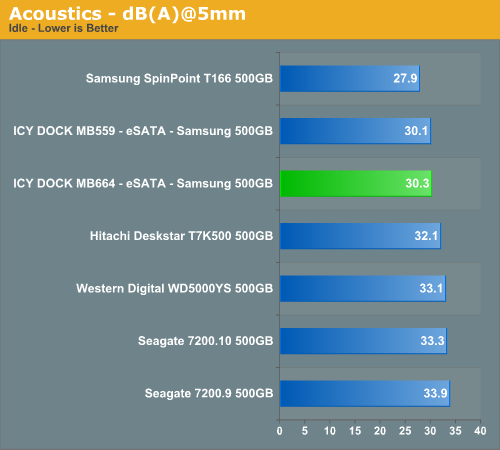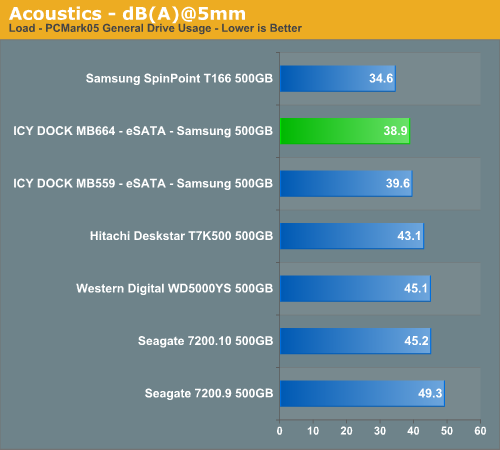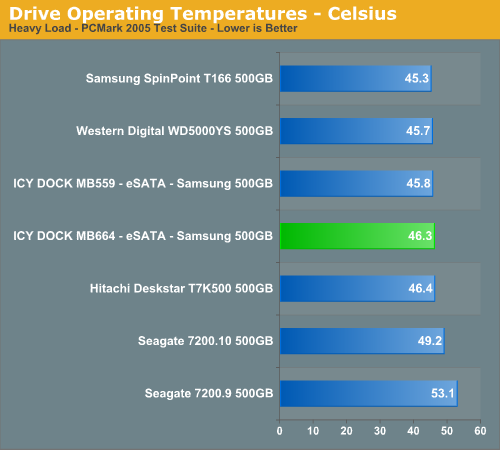ICY DOCK MB664US-1S: eSATA with a twist
by Dave Robinet on October 9, 2007 1:00 PM EST- Posted in
- Storage
Acoustics
Our acoustic test utilizes our standard test bed components but we implement Intel's power saving technology and turn off the case fans to isolate as much case noise as possible during testing. Our Corsair power supply is nearly silent in these tests and our MSI 8800GTX video card is water cooled to provide a further decrease in ambient noise levels.
Our acoustic tests are designed to measure the decibel levels while the system is at idle and also under load while running the General Hard Disk Drive Usage benchmark within PCMark 2005. We found through trial and error that this particular benchmark produces controlled readings across a wide range of applications within the benchmark. This particular benchmark utilizes 60% reads and 40% writes within the trace playback file.
The measurements are taken at a distance of 5mm from the rear and front of the drive being tested in order to minimize surrounding environmental noise. We have noticed that unless we run a completely silent system in a quiet room that measurements taken from 1m are generally not meaningful due to ambient noise levels. Being an external enclosure that might be found sitting on a desk, HDD noise levels with the ICY DOCK may be slightly more noticeable than a hard drive installed in a typical tower.
The reported measurements are based on an A-weighted decibel score that measures frequencies similar to the way the human ear responds to sound. We take a total of three measurements for each test. We then subtract the high and low scores and arrive at our findings by reporting the remaining score.


The MB664 comes in slightly quieter than the MB559, largely due the MB664's use of a "slide-in" design, rather than a detachable caddy. The difference, however, is minor and not likely to be noticeable in most conditions. As in the review of the MB559, the SpinPoint drive in the review has a tendency to vibrate, which caused a hum in our ICY DOCK enclosure. Our base noise level in the room at the time of testing was 25 dB(A).
Thermals
Our thermal tests utilize sensor readings via the S.M.A.R.T. (Self-Monitoring, Analysis and Reporting Technology) capability of the drives and are reported by utilizing the Active SMART 2.42 utility. We also utilize thermal sensors and infrared measurement devices to verify our utility results. Our base temperature level in the room at the time of testing was 25C.


The ICY DOCK MB664 was able to dissipate the heat of the Samsung drive without issue. As was the case in the MB559, the enclosure itself consumes only 2W of power at idle, largely due to the absence of any active cooling solution. This low power consumption contributes to the low thermal output increases we noticed compared to the drive in a standard case configuration.
Our acoustic test utilizes our standard test bed components but we implement Intel's power saving technology and turn off the case fans to isolate as much case noise as possible during testing. Our Corsair power supply is nearly silent in these tests and our MSI 8800GTX video card is water cooled to provide a further decrease in ambient noise levels.
Our acoustic tests are designed to measure the decibel levels while the system is at idle and also under load while running the General Hard Disk Drive Usage benchmark within PCMark 2005. We found through trial and error that this particular benchmark produces controlled readings across a wide range of applications within the benchmark. This particular benchmark utilizes 60% reads and 40% writes within the trace playback file.
The measurements are taken at a distance of 5mm from the rear and front of the drive being tested in order to minimize surrounding environmental noise. We have noticed that unless we run a completely silent system in a quiet room that measurements taken from 1m are generally not meaningful due to ambient noise levels. Being an external enclosure that might be found sitting on a desk, HDD noise levels with the ICY DOCK may be slightly more noticeable than a hard drive installed in a typical tower.
The reported measurements are based on an A-weighted decibel score that measures frequencies similar to the way the human ear responds to sound. We take a total of three measurements for each test. We then subtract the high and low scores and arrive at our findings by reporting the remaining score.


The MB664 comes in slightly quieter than the MB559, largely due the MB664's use of a "slide-in" design, rather than a detachable caddy. The difference, however, is minor and not likely to be noticeable in most conditions. As in the review of the MB559, the SpinPoint drive in the review has a tendency to vibrate, which caused a hum in our ICY DOCK enclosure. Our base noise level in the room at the time of testing was 25 dB(A).
Thermals
Our thermal tests utilize sensor readings via the S.M.A.R.T. (Self-Monitoring, Analysis and Reporting Technology) capability of the drives and are reported by utilizing the Active SMART 2.42 utility. We also utilize thermal sensors and infrared measurement devices to verify our utility results. Our base temperature level in the room at the time of testing was 25C.


The ICY DOCK MB664 was able to dissipate the heat of the Samsung drive without issue. As was the case in the MB559, the enclosure itself consumes only 2W of power at idle, largely due to the absence of any active cooling solution. This low power consumption contributes to the low thermal output increases we noticed compared to the drive in a standard case configuration.










19 Comments
View All Comments
Souka - Friday, October 12, 2007 - link
Drives have two basic benchmarks... latency and throughput.comments like, "a 500gb is almost equal"..or "those raptors are not worth the cost" kinda ignore the latency part of the equation.
Yes, most 500GB drives equal, perhaps surpass, an older 150gb Raptor in some throughput benchmarks. But latency is still the raptors domain, and overal performance benifts quite a bit from this.
There are plenty of articles on such a topic...
My $.02
retrospooty - Tuesday, October 9, 2007 - link
"The fact is for the price of a 150GB raptor you can get a 500-750GB drive that performs almost as well. Now that there are better performing drives available, those raptors just are not worth the cost anymore."almost as well, yes, but the 150gb Raptor is 2 years old now, it was released on Jan 1st 2006. They are due for an update any time now (prolly Jan 1st 2008) and you can bet that a 300g (or higher) Raptor with 32mb cache and Perpendicular recording will own the market once again by a large margin.
lennylim - Tuesday, October 9, 2007 - link
I bought the MB559. The attraction to me is that I can get additional trays for $20 (expensive, but not too expensive). At $70 for one enclosure, this seems overpriced.The power connector on the bracket is very attractive to me, actually. I wish the MB559 comes with one. They had a MIR last month where you can get one free if you bought a MB559, but I bought mine too early. You can have the bracket installed on your home machine, so that you can have the power adapter in your laptop bag all the time. And reducing a wall wart is always a good idea to me. The bracket us available for purchase, but at over $20 shipped, it's too expensive for me.
ninjit - Tuesday, October 9, 2007 - link
The product info for the MB664US-1S on ICY DOCK's website touts the ability to hotswap the actual hard-drive in the enclosure.Did you test this, and/or have any comments?
FrankThoughts - Tuesday, October 9, 2007 - link
Page three says "We implemented AHCI (Advanced Host Controller Interface) in the BIOS to properly test the hot swap capabilities of this drive enclosure when utilizing the eSATA interface. Without the proper matrix storage driver support and AHCI implementation, hot swapping was not possible with our test bed."I would assume that means with the test chipset and those drivers installed, hotswap works. Using it with other chipsets and drivers? Sounds like something they could maybe test further on other systems.
Olaf van der Spek - Tuesday, October 9, 2007 - link
Why is power over SATA never used? Then you could stick with a single connector and not need the external power supply (except when you use USB).ninjit - Tuesday, October 9, 2007 - link
There is no power over SATA.the SATA spec designed a NEW power connector, over the old Molex one, which is inline with the data-connector allowing easy cable-less drive installations, through direct mating to backplanes, but it's still a separate power connector and needs its own cable otherwise.
eSATA (which is what's tested here with the ICY-DOCK) is just data, there is no associated external power port to go a long with it.
Olaf van der Spek - Tuesday, October 9, 2007 - link
> There is no power over SATA.Not over the SATA data cable, no.
Let's rephrase the question: why aren't SATA connectors/cables used that transport both data and power?
Souka - Friday, October 12, 2007 - link
Well, here's my thoughts why.1. The power would then have to come from the motherboard, which means more tracepaths on the circuit board and power drawn from the motherboard itself.
2. SATA cables would be bigger, and you'd have two SATA cable standards
3. Power and data on same cable for SATA might cause interference with the data trasnsfer quality.
4. Power and Data on a mass storage device hasn't been the standard in the past, and changing standards is a risk manufacturers often won't take.
My $.02